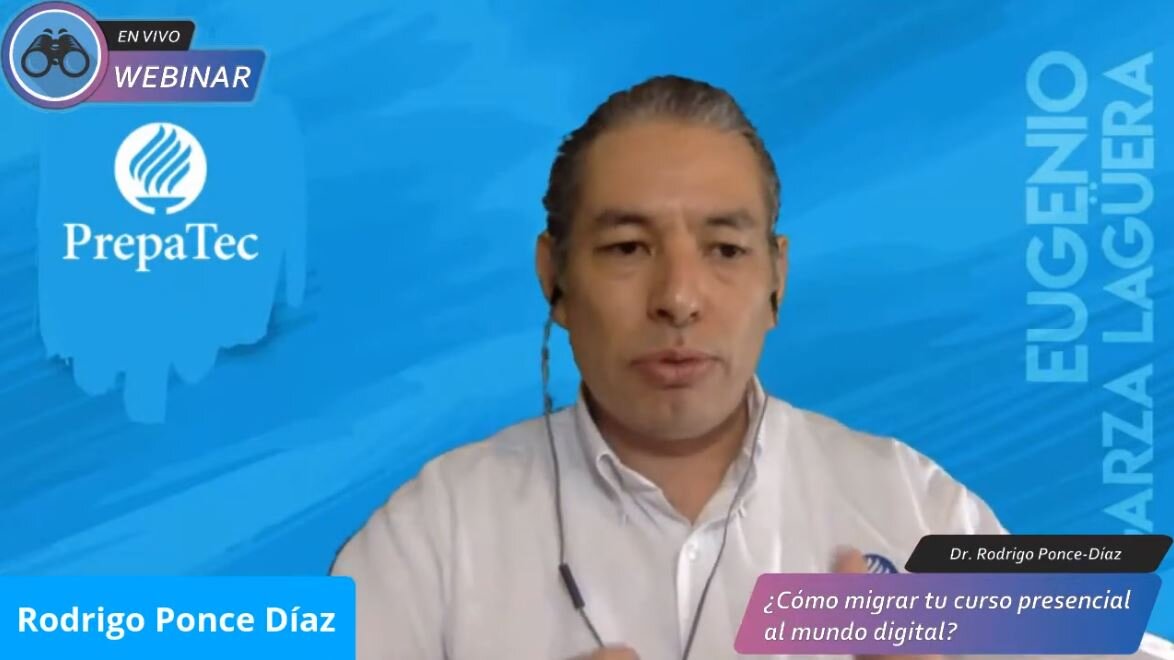“Educational planning for a course (face-to-face or online) must have solid foundations of pedagogical and epistemological theories.”
Before the pandemic, virtual or online education was optional. Now it is practically mandatory. In our October webinar, Dr. Rodrigo Ponce shared a simple and intuitive methodology for migrating face-to-face courses to the digital world. This guide will be of great use to you, even if you are already teaching virtual classes. With it, you can make necessary adjustments and changes to improve the virtual experience of your course.
In this session, we review with Professor Rodrigo the relevance of always considering pedagogical bases in school planning, whether in a face-to-face or virtual context. He also shares a structured five-step guide to digital educational migration that explains how to integrate technology into each of these stages and provides the tools to perform this migration in an orderly and systematic manner. With these steps, you will be able to review your current teaching exercise and improve it.
“We face a real current problem: to rethink and solve education in a new context at a distance, online or remotely, to get ahead of the health contingency we are experiencing.”
We are confronting real cognitive conflict
Overnight, we had to face the challenges of not attending the classroom in person due to the COVID-19 pandemic, finishing the school year, and preparing for the new cycle. To date, we still do not know when we will return to the classroom physically. We suddenly realized that the activities we had designed and taught for years in person were no longer applicable. We had to rethink the situation within a new educational context and migrate everything to a digital environment. All of this meant that we faced a real, existing problem, which was to resolve the challenges of remote, online education and move forward from this health contingency. Dr. Rodrigo explains it this way in the Observatory of Educational Innovation webinar.
Below, I share the five steps to achieve digital educational migration. For more information, please watch the recorded broadcast on our Facebook or YouTube pages. Don’t miss it!
The 5 Steps of Digital Education Migration
Step 1: Planning for Digital Learning.
The first step is to determine what to teach students in the online session, considering the final product. For example, 1) we are going to convey knowledge, or we want the students to understand a concept, 2) we want to develop in them a particular ability to build or do something, 3) we want them to have the right attitude to take on a specific problem, or 4) we want to develop in them values derived from everything we did in class so they can come up with resolutions.
Step 2: Synchronous session time.
An asynchronous session is when we interact directly with students through an app like Zoom or something similar. On the other hand, an asynchronous session is when we leave the students an activity with a specific purpose to work on themselves. Time management in a synchronous session is crucial. That is why we must consider the next point.
The teacher’s time vs. the students’ time.
We must be aware that students process and develop their analyses at a different rate than the teacher. It is common for the teachers to apply the same problems, challenges, or case studies in their other classes and semesters. So, the teachers already know the problem and have studied it from various perspectives, while for students, it is entirely new. Thus, we must not assume that the students’ time to solve a problem is the same; it takes more time to resolve the same dilemma or problem because they are dealing with it for the first time. Therefore, we must consider the cognitive process that students will undergo and estimate sufficient times for each assignment.
Step 3: Interactions with students.
Consider the students’ and teachers’ circumstances, such as the devices available to them and the stability of their internet connections. Determine the most appropriate means of interaction according to the needs of each one. What kinds of interactions can we carry out? We can interact in many ways in an online class. Here are some options for a more dynamic class and the applications to use:
-
Synchronous (Zoom, Google Meet, Microsoft Teams)
-
Asynchronous (Google Classroom, Canvas, Blackboard, Edmodo)
-
Student-to-student (Email, Facebook groups, Messenger, WhatsApp, Remind)
-
Student-to-teacher (What the teacher considers official for the class may be one of the above.)
Step 4: Digital stimulus is not everything.
Achieving a balance between pedagogy and technology is the key. Technology alone does not develop knowledge as it is only a medium. So how does learning develop? We need to review the theoretical and epistemological foundations of learning and then review what technologies will support these to achieve it.
Select non-digital stimuli also because they are essential and will never go out of style. Examples are crafts, home experiments, peer discussions, field observations, and bibliographic research. In this webinar video, you can find the ten most used educational technologies for digital components.
Step 5: Assessment beyond online exams.
Many digital applications replicate face-to-face exams in a digital format. However, the intention is to go further by not sticking only to traditional exams but rather adding other learning evidence. For example, for tasks or projects, use rubrics, checklists, or check-ins. The evaluation planning process should consider the following elements:
-
The element to evaluate.
-
The digital platform or tools.
-
The time spent on evaluation.
To learn more about each of the points discussed in this article, I invite you to watch the webinar, available at any time, study it thoroughly and share it with your colleagues.
Rodrigo Ponce Díaz (rponce@tec.mx) is Director of the Prepa Tec Eugenio Garza Lagüera, where he also teaches the International Baccalaureate Physics class. He holds a Ph.D. in Information and Communications Technologies from Tecnológico de Monterrey. In this same institution, he has directed several Educational Innovation projects.
If your native language is not Spanish, you can enable translated subtitles on YouTube. (See the link included in this article.) To enable this option (the subtitles will appear in Spanish), select the Subtitles option on YouTube, then select Settings -> Subtitles -> Translate automatically, choose the language you prefer.
Translation by Daniel Wetta.
This article from Observatory of the Institute for the Future of Education may be shared under the terms of the license CC BY-NC-SA 4.0 
)
)


)